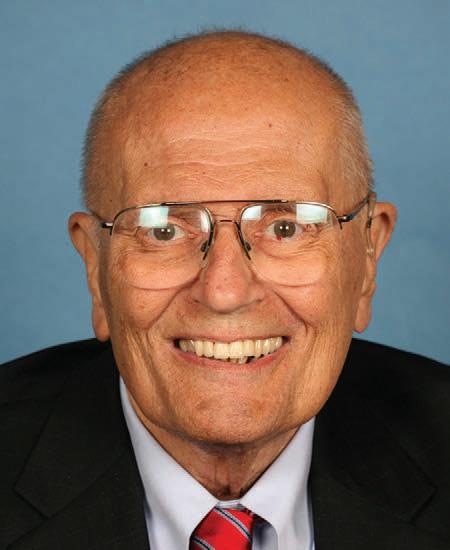Tribute to Long-Time Automotive Industry Supporter, Representative John Dingell
February 11, 2019
A public visitation will be held today, February 11, in Michigan to honor John Dingell, the longest-serving member of Congress in history, who died last week at age 92. The visitation will be at Ford Community and Performing Arts Center in his hometown of Dearborn, a Detroit suburb. A funeral will be held Tuesday at a local church.
Dingell, the longest-serving member of Congress in American history, mastered legislative deal-making and was fiercely protective of Detroit’s automotive industry.
Dingell began his lifetime of service as a Congressional page when he was just 12-years-old in the U.S. House of Representatives from 1938 to 1943, where as a 15-year-old he watched president Roosevelt give his famous “Date Which Live In Infamy” speech following the Japanese attack on Pearl Harbor from the House floor.
In 1944, he joined the U.S. Army, where he rose to second lieutenant and would have had to participate in an invasion of Japan had the two atomic bombs dropped on that country not ended the war. He then went on to get his law degree from Georgetown and, in 1955, won a special election to replace his recently deceased father, Rep. John Dingell, Sr., as representative for the 15th Congressional district in Michigan.
The next year, he won his first full term. He would go on to be reelected 29 times.
During debate in 1977 to amend the Clear Air Act, Dingell worked for a favorable outcome for the car industry, instead of the air. The 1977 revision addressed specifically automobile emissions and in particular three pollutants—hydrocarbons (HC), carbon monoxide (CO) and nitrogen oxide (NOx).
Auto industry executives had already received three postponements to implementing these standards—two by the EPA and one by Congress—and insisted after seven years their companies still could not meet standards. While the auto companies did gain another extension, the bill did not include the relaxed targets that Dingell was pushing for.
Dingell claimed on the House floor that there was “no quantified evidence” of health hazards caused by automobile carbon monoxide in the open, a claim his fellow Democrats roundly rejected. And while a more relaxed amendment called the Dingell-Broyhill substitute almost made it into the bill, but died in a tie vote in committee. In protest, Dingell refused to sign the conference report that lead to the 1977 Clear Air Act and actually apologized to automotive industry executives for not furthering their interests, Congressional Quarterly noted at the time.
In the 1980s, Dingell again went to bat for the auto industry. He worked with Reagan to loosen emission targets, and when charcoal canisters designed to filter gasoline vapor were being debated, Dingell called the gadgets “motorized bombs.” From a 1989 Congressional Quarterly article:
“Gasoline vapor, though a relatively minor contributor to urban smog problems, had been classified by the EPA as a probable carcinogen that caused an estimated 75 cancer deaths a year.
But Dingell harshly attacked the canisters as potentially hazardous devices that could turn automobiles into “motorized bombs.” “If you want to ride around in exploding vehicles … you can support this amendment with enthusiasm,” he said.
But by 1990, Dingell’s attitude had softened a bit, and a new Clear Air Act was passed, ending a 10-year stalemate over emission regulations, mainly held up by John Dingell.
It may be thanks to Dingell that we have companies like General Motors and Chrysler today, as there was no stronger champion of the automotive bailouts in 2008 and 2009. He gave constant speeches, made personal calls to the president and offered quid pro quo for support of the “Cash for Clunkers” program. He pushed for at least five bailouts, according to the Washington Post, ultimately securing billions for General Motors and Chrysler.
“I’ve never known a man who has been a better champion of the American worker, and he deserves a great deal of credit for the resurgence of the iconic American automobile industry,” Vice President Joe Biden told Automotive News about Dingell.
As chair of the powerful Energy and Commerce Committee he was well positioned to plead the case of the Big Three and, of course, for Big Oil. This stance led to him butting heads with fellow Democrats who consistently have wanted to raise emission standards for decades. He fought against every attempt to curb automotive emissions, earning him the unflattering, but perhaps fitting, nickname “Tailpipe Johnny.”
Even after losing his chair, Dingell still fought for the auto industry, personally writing President Obama and urging him to make more funds available to the industry.
Dingell retired from the House in 2015, becoming one of the last people to serve in World War II to leave Congress.
John Dingell is survived by his wife, Rep. Debbie Dingell, who took over his old seat, and four children from a previous marriage.
Marquis, Erin. (2019). “John Dingell, The Car Industry’s Congressman, Dies 92”. Retrieved from https://jalopnik.com/john-dingell-the-car-industrys-congressman-has-died-a-1832394975.
